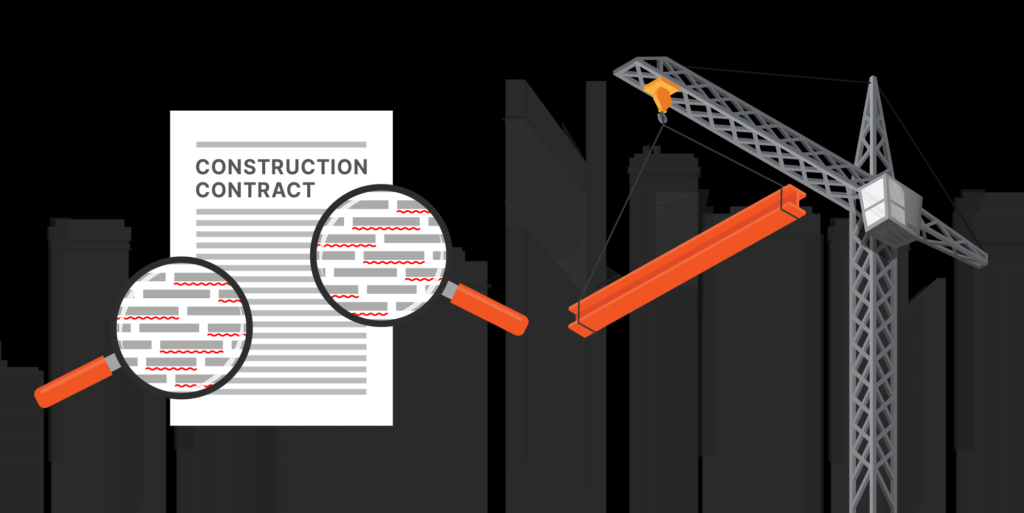— 13 min read
Who’s Accountable? The Spearin Doctrine and Construction Responsibilities


Last Updated May 23, 2024

Peter Ryan
Peter J. Ryan, Esq. is a construction attorney from California. Ryan advises general contractors, subcontractors, construction managers, owners, developers and property managers in complex construction contract, project administration, and litigation matters. Ryan enables clients to manage risks by structuring and negotiating complex construction contracts, joint venture agreements, MOUs, commercial leases, non-securitized debt, and real estate transactions. With a litigation practice in both state and federal courts, Ryan has expertise in the nuances applicable to private, public, and federal construction projects in California and strategically advances his clients’ claims in all applicable forums including mediation and arbitration as well as bench and jury trials in state and federal courts. Ryan has served as local counsel for national companies with respect to construction and real estate disputes in California as well as national counsel for the coordination multijurisdictional matters. Peter Ryan was exposed to the construction industry at an early age via his grandfather’s electrical contracting business, which his father also served as president, and he interned at, learning the nuances of management, estimating, design, and field work. He is excited by the rapid rate of technologically driven advances allowing for safer, more efficient, and cost-effective projects and seeks to leverage these technologies to deliver superior solutions for clients in the context of disputes, negotiations, and risk management.

Taylor Riso
Contributing Writer
91 articles
Taylor Riso is a marketing professional with more than 10 years of experience in the construction industry. Skilled in content development and marketing strategies, she leverages her diverse experience to help professionals in the built environment. She currently resides in Portland, Oregon.
Last Updated May 23, 2024

Contractors and subcontractors are expected to follow the instructions in their contracts, but sometimes, these instructions can have mistakes or gaps. When this happens, it's often unclear who should be held accountable for the problems.
This is where the Spearin Doctrine comes into play, a pivotal yet often misunderstood principle within the nuances of construction law.
In this article, we dive into the Spearin Doctrine, covering its history, how it’s evolved and practical advice for contractors on navigating its complexities.
Table of contents
What is the Spearin Doctrine?
The Spearin Doctrine is fundamentally defined by the implied warranty that the project owner, often a governmental entity in public works, guarantees the accuracy of the provided specifications.
When contractors follow these specifications precisely, any resultant issues or defects fall under the responsibility of the owner, not the contractors. This doctrine ensures that contractors can rely on the project plans and specifications with confidence, mitigating their risk should discrepancies arise.
The Spearin Doctrine applies to both public and private construction projects, though its impact varies by the type of project and the legal environment.
In public projects, the doctrine is particularly crucial due to the competitive bidding process, which requires contractors to adhere strictly to predefined plans and specifications. Private projects offer more contractual flexibility, allowing for adjustments and negotiations over the terms of plan accuracy and defect liability.
In California, for instance, while the Spearin Doctrine is recognized across both public and private sectors, private contracts often include clauses that allow modifications to the standard provisions. This flexibility in private contracts highlights the importance of understanding specific state laws and contractual freedoms to effectively manage the risks associated with construction specifications and responsibilities.
Historical Context and the Evolution of the Spearin Doctrine
The Spearin Doctrine originates from a landmark 1918 Supreme Court case, United States v. Spearin. The case involved a contractor named George B. Spearin who was hired by the U.S. government to construct a dry dock at the Brooklyn Navy Yard. As part of the project, Spearin was instructed to relocate a sewer according to plans provided by the government. After completing the work, heavy rainfall and other factors caused the sewer to fail, leading to significant flooding and damage.
The government initially blamed Spearin for the failure, suggesting that the contractor should have foreseen and mitigated the potential for such issues. Spearin contended that he had followed the government’s specifications exactly as provided.
The Supreme Court ruled in favor of Spearin, establishing that if a contractor is directed to build according to specific plans provided by the owner (in this case, the government), then the owner guarantees the adequacy of those plans. This case set a precedent that if a contractor adheres to the plans and specifications that turn out to be flawed, the liability for any resultant damages rests with the owner, not the contractor.
Since its establishment, the Spearin Doctrine has been applied and interpreted in various cases across different states, reflecting its adaptability and continued relevance. The doctrine’s core premise — that the owner implicitly assures the adequacy of the plans and specifications — has been upheld consistently. However, its application has nuanced differences depending on jurisdiction and the specific circumstances of each case.
For example, later cases have further explored and defined the limits of this implied warranty, particularly in scenarios where the specifications were not entirely clear or where the contractor should have recognized and questioned potential issues based on their professional expertise.
The Practical Applications and Implications of the Spearin Doctrine
The Spearin Doctrine serves as a vital legal safeguard for contractors, underscoring the significant implications it has on the management of construction projects. It delineates specific responsibilities and provides recourse in situations where project specifications are flawed.
The Contractor’s Duty: Review and Compliance
Under the Spearin Doctrine, contractors have specific responsibilities that are crucial for both compliance and protection under the doctrine.
First, contractors are obligated to follow the specifications and plans provided by the project owner meticulously. This adherence is fundamental, as it forms the basis of the implied warranty that if followed, the responsibility for any deficiencies lies not with the contractor but with the owner who provided them.
However, it's not just about following the plans — contractors also have a duty to conduct a thorough review of the physical site or structure. This means that prior to bidding or starting the work, contractors must familiarize themselves with the site conditions to ensure that there are no obvious discrepancies with the plans provided. If site conditions significantly differ from those outlined, contractors must raise concerns through formal channels, typically in the form of a Request for Information (RFI). This due diligence is essential, as it allows contractors to identify potential conflicts or issues that might affect their ability to execute the project as specified.
Elements Required for the Spearin Doctrine to Apply
The application of the Spearin Doctrine hinges on four critical elements that must be satisfied for a contractor to successfully invoke its protections. These elements ensure that the responsibility for any project failure due to defective plans and specifications falls on the entity that provided them, the project owner.
1. Provision of Plans and Specifications by the Owner
The first requirement is that the owner provides all necessary plans and specifications for the project. This element is generally straightforward in public works, where detailed plans and specifications form an integral part of the bid package. The provision of these documents implies a warranty that they are accurate and fit for the intended purpose, establishing a foundational trust in their viability.
2. Mandatory Adherence to Provided Plans and Specifications
Contractors must follow the provided plans and specifications precisely, as dictated by their contract. This strict adherence is crucial, as it underscores the reliance on the integrity of the provided documents. The legal expectation is that if a contractor follows these plans to the letter, they should not be liable for any resultant defects solely due to those plans.
3. Reasonable Reliance on the Provided Plans and Specifications
The contractor's reliance on the provided plans must be reasonable. This element often becomes pivotal in legal disputes, as what constitutes “reasonable” can vary, case by case. The courts will consider whether a competent contractor should have identified potential issues in the plans. Unreasonable reliance, where obvious flaws could have been identified before construction, might not be protected under the Spearin Doctrine.
The concept of reasonable reliance under the Spearin Doctrine is fraught with complexities, as it hinges on the contractor's ability to discern and react to potential errors in project specifications. For instance, a contractor is permitted to rely reasonably on the accuracy of provided plans. However, this reliance becomes unreasonable if the contractor encounters elements that, by virtue of their professional experience, should be recognized as flawed or insufficient. If observable issues such as environmental conditions or structural integrity concerns are evident and could impact the project's success, the contractor has a duty to raise these issues through proper channels like RFIs (Requests for Information).
Failing to do so can shift the liability back to the contractor, illustrating an instance of unreasonable reliance. This differentiation emphasizes the necessity for contractors to actively engage with the plans they are given and to communicate any discrepancies or concerns effectively to avoid potential pitfalls in the application of the Spearin Doctrine.

Peter Ryan
4. The Defect or Issue Arose Because the Plans and Specifications Were Incorrect
Finally, there must be a demonstrable link between the contractor’s adherence to the plans and the project's failure. The contractor must prove that the failure was due to inaccuracies or defects in the provided plans. This direct causation between the plans' defects and the project failure is essential for the doctrine to apply.
These elements collectively ensure that contractors can execute their work with confidence in the provided specifications, securing their protection under the law when those specifications are flawed.
The careful application of the Spearin Doctrine not only shields diligent contractors but also reinforces the accountability of project owners, fostering a more equitable construction environment.
Challenges and Considerations in Applying the Spearin Doctrine
Navigating the complexities of the Spearin Doctrine requires a keen understanding of its provisions and implications. This section explores these challenges and offers practical advice to help contractors effectively manage their responsibilities and safeguard their interests.
Challenges
Applying the Spearin Doctrine effectively demands not only a clear understanding of its legal framework but also a meticulous approach to project management.
Common Misconceptions
One significant challenge in applying the Spearin Doctrine lies in addressing common misconceptions among contractors. Many believe that strict adherence to provided plans and specifications fully absolves them of any responsibility for subsequent project issues. This misunderstanding can lead contractors to neglect their duty to conduct a comprehensive review of the plans and to question any potential discrepancies or ambiguities, increasing the risk of project failure due to unrecognized flaws. It is crucial for contractors to realize that while the doctrine offers protection, it does not provide immunity if the plans are clearly inadequate or fail to consider specific project conditions.
Interpreting Plans Accurately
Contractors must ensure they accurately interpret and apply the details of the plans and specifications. Misinterpretations can lead to incorrect implementations, which might not be covered under the Spearin Doctrine if the errors were avoidable with careful review or requests for information/clarification.
Documentation and Communication
Effective documentation and proactive communication form the backbone of legal protection under the Spearin Doctrine. Contractors should maintain detailed records of all interactions, decisions and clarifications to defend their adherence to specifications and their responses to any encountered issues.
Legal and Technical Expertise
Contractors should seek periodic reviews of project specifications by legal and technical experts. This step helps identify potential legal vulnerabilities and technical errors in the plans before they lead to costly disputes or construction failures.
Considerations for Contractors
To navigate the complexities of construction projects and safeguard themselves legally, contractors should adopt a proactive approach when dealing with plans and specifications. Here are several tips:
1. Thoroughly Review and Perform Due Diligence
Before beginning any project, thoroughly review all provided plans and specifications and satisfy yourself with the general conditions on-site. Understand every detail and requirement to identify potential issues or areas where specifications may not be sufficient for the actual conditions of the site.
2. Use RFIs
Leverage RFIs as a formal tool for clarification, ensuring all ambiguities are addressed before they lead to larger issues. RFIs allow contractors to clarify any doubts and document these interactions, providing a crucial paper trail that can be invaluable in case of disputes.
3. Document, Document, Document
Maintain meticulous records of all communications, including RFIs, emails and meeting notes related to plan reviews and any issues raised. Proper documentation ensures that there is evidence to support the contractor’s actions and decisions, reinforcing their position if a legal defense becomes necessary under the Spearin Doctrine.
4. When in Doubt, Seek Expert Advice
If there are any uncertainties, consult with engineers, architects, or legal experts to evaluate the feasibility and safety of the plans and specifications. This expert input can provide an additional layer of security and insight, helping to prevent potential project failures attributable to defective specifications.
By implementing these strategies and understanding the intricacies of the Spearin Doctrine, contractors can effectively manage their legal risks and contribute to successful project outcomes. By proactively tackling these issues head-on, contractors can not only safeguard their interests but also uphold the standards of quality and safety in the construction industry.
Modern Interpretations and Adjustments of the Spearin Doctrine
As the construction industry continues to evolve, so too does the legal framework that governs contractual relationships and project responsibilities. The Spearin Doctrine, established to protect contractors from defects in provided specifications, has faced significant reinterpretation in response to new contractual practices and emerging case law.
Shifts in the Legal Landscape
Modern interpretations of the doctrine reflect adjustments in how contracts are drafted and enforced, particularly in public works projects. Historically, the doctrine provided a robust defense for contractors against defects in provided plans and specifications. However, recent case law and contractual modifications, including the strategic use of general conditions, have begun to refine these protections, emphasizing a more balanced allocation of risks between the project owners and contractors.
Contracts are now often drafted with clauses that explicitly limit the application of the Spearin Doctrine by requiring contractors to perform additional due diligence or assume greater responsibility for project oversight. For example, construction contracts may include terms that oblige contractors to independently verify the adequacy of provided specifications or to take greater initiative in identifying potential design flaws before kicking off construction.
These changes reflect a shift towards placing more responsibility on contractors to ensure that all aspects of a project are feasible before proceeding, thereby mitigating the legal leverage provided by strict reliance on the Spearin Doctrine.
Performance Specifications and Contractor Responsibilities
In modern contracting, particularly with the rise of design-build and integrated project delivery methods, there is an increasing trend toward performance specifications. While the Spearin Doctrine does not apply to contracts where the contractor takes on responsibility for the design, this shift has significant implications for how responsibilities are allocated under the Spearin Doctrine for contracts that still place design responsibility on the Owner. Performance specifications focus on the outcomes rather than the means by which those outcomes are achieved. This approach allows contractors more flexibility in determining how to meet project goals but also shifts a greater burden of responsibility onto them to ensure that the chosen methods meet the contractual performance criteria.
The evolving interpretations of the Spearin Doctrine in the context of performance specifications mean that contractors may no longer rely solely on the adherence to detailed prescriptive plans provided by the owner. Instead, they must ensure that their chosen methods and materials meet the performance outcomes stipulated in the contract. This shift can potentially reduce or eliminate the applicability of the Spearin Doctrine as a defense, as the onus is on contractors to prove that any failure to meet performance standards was due to deficiencies in the specifications themselves and not due to their chosen methods or materials.
These modern adjustments in contract law and the interpretation of the Spearin Doctrine highlight the need for contractors to be thoroughly versed in both the legal and practical requirements of their projects. As contractual frameworks become more complex and shift toward shared risk models, contractors must navigate these changes strategically to protect their interests while ensuring project success.
Secure Project Outcomes with Structured Contracts
Contracts serve not just as legal bindings but as frameworks for clear and effective collaboration. In the realm of construction, the Spearin Doctrine has played a crucial role in defining responsibilities, particularly when unforeseen issues arise from provided specifications. As contractual practices evolve, clarity in the drafting of these agreements becomes paramount. By incorporating precise definitions and responsibilities within the terms and conditions, stakeholders can preemptively address potential ambiguities.
Ultimately, the most successful projects are those where every party, from the owner to the briefest onsite subcontractor, operates under a shared understanding fostered by clear, well-structured contracts. The ongoing refinement of the Spearin Doctrine and its integration into modern contractual frameworks underscore the importance of adaptability and precise communication in achieving common goals across the construction industry.
Was this article helpful?
Thank you for your submission.
100%
0%
You voted that this article was . Was this a mistake? If so, change your vote
Scroll less, learn more about construction.
Subscribe to The Blueprint, Procore’s construction newsletter, to get content from industry experts delivered straight to your inbox.
By clicking this button, you agree to our Privacy Notice and Terms of Service.
Thank you!
You’re signed up to receive The Blueprint newsletter from Procore. You can unsubscribe at any time.
Categories:
Written by

Peter Ryan
Peter J. Ryan, Esq. is a construction attorney from California. Ryan advises general contractors, subcontractors, construction managers, owners, developers and property managers in complex construction contract, project administration, and litigation matters. Ryan enables clients to manage risks by structuring and negotiating complex construction contracts, joint venture agreements, MOUs, commercial leases, non-securitized debt, and real estate transactions. With a litigation practice in both state and federal courts, Ryan has expertise in the nuances applicable to private, public, and federal construction projects in California and strategically advances his clients’ claims in all applicable forums including mediation and arbitration as well as bench and jury trials in state and federal courts. Ryan has served as local counsel for national companies with respect to construction and real estate disputes in California as well as national counsel for the coordination multijurisdictional matters. Peter Ryan was exposed to the construction industry at an early age via his grandfather’s electrical contracting business, which his father also served as president, and he interned at, learning the nuances of management, estimating, design, and field work. He is excited by the rapid rate of technologically driven advances allowing for safer, more efficient, and cost-effective projects and seeks to leverage these technologies to deliver superior solutions for clients in the context of disputes, negotiations, and risk management.
View profile
Taylor Riso
Contributing Writer
91 articles
Taylor Riso is a marketing professional with more than 10 years of experience in the construction industry. Skilled in content development and marketing strategies, she leverages her diverse experience to help professionals in the built environment. She currently resides in Portland, Oregon.
View profileExplore more helpful resources

Using Standard Operating Procedures for Better Contract Management
Every construction project is different, meaning that GCs have to be continually agile and strategic about applying their experience. Major categories change from project to project, from the owner to...

Understanding Supplementary Conditions on Construction Contracts
No two construction projects are exactly alike — and the same goes for construction contracts. Even when using a standard contract form, owners and contractors sometimes use supplementary conditions to...

A Straightforward Guide to Construction Contract Review
Construction contracts are like the glue for the project team. They’re the ties that bind the working relationships and goals for the project, containing information about responsibilities, liabilities and processes...

Escalation Clauses in Construction Contracts: When and How They Apply
In construction contracts, an escalation clause allows for the escalation of a certain price for labor or materials to be used in a construction project. This type of clause is most...
Free Tools
Calculators
Use our calculators to estimate the cost of construction materials for your next project.
Templates
Find a template to help you with your construction project tasks.
Material Price Tracker
Get the latest U.S. retail prices and view historical trends for common building materials.
Glossary
Explore key terms and phrases used in the industry.
